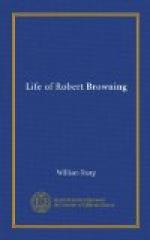“Rossetti’s ‘Pauline’ letter was addressed to me at Florence more than thirty years ago. I have preserved it, but, even were I at home, should be unable to find it without troublesome searching. It was to the effect that the writer, personally and altogether unknown to me, had come upon a poem in the British Museum, which he copied the whole of, from its being not otherwise procurable—that he judged it to be mine, but could not be sure, and wished me to pronounce in the matter—which I did. A year or two after, I had a visit in London from Mr. (William) Allingham and a friend—who proved to be Rossetti. When I heard he was a painter I insisted on calling on him, though he declared he had nothing to show me—which was far enough from the case. Subsequently, on another of my returns to London, he painted my portrait, not, I fancy, in oils, but water-colours, and finished it in Paris shortly after. This must have been in the year when Tennyson published ‘Maud,’ for I remember Tennyson reading the poem one evening while Rossetti made a rapid pen-and-ink sketch of him, very good, from one obscure corner of vantage, which I still possess, and duly value. This was before Rossetti’s marriage."[8]
[Footnote 8: The highly interesting and excellent portrait of Browning here alluded to has never been exhibited.]
As a matter of fact, as recorded on the back of the original drawing, the eventful reading took place at 13 Dorset Street, Portman Square, on the 27th of September 1855, and those present, besides the Poet-Laureate, Browning, and Rossetti, were Mrs. E. Barrett Browning and Miss Arabella Barrett.
When, a year or two ago, the poet learned that a copy of his first work, which in 1833 could not find a dozen purchasers at a few shillings, went at a public sale for twenty-five guineas, he remarked that had his dear old aunt been living he could have returned to her, much to her incredulous astonishment, no doubt, he smilingly averred, the cost of the book’s publication, less L3 15s. It was about the time of the publication of “Pauline” that Browning began to see something of the literary and artistic life for which he had such an inborn taste. For a brief period he went often to the British Museum, particularly the Library, and to the National Gallery. At the British Museum Reading Room he perused with great industry and research those works in philosophy and medical history which are the bases of “Paracelsus,” and those Italian Records bearing upon the story of Sordello. Residence in Camberwell, in 1833, rendered night engagements often impracticable: but nevertheless he managed to mix a good deal in congenial society. It is not commonly known that he was familiar to these early associates as a musician and artist rather than as a poet. Among them, and they comprised many well-known workers in the several arts, were Charles Dickens and “Ion” Talfourd. Mr. Fox, whom Browning had met once or twice in his early youth, after the former had been shown the Byronic verses which had in one way gratified and in another way perturbed the poet’s father, saw something more of his young friend after the publication of “Pauline.” He very kindly offered to print in his magazine any short poems the author of that book should see fit to send—an offer, however, which was not put to the test for some time.




